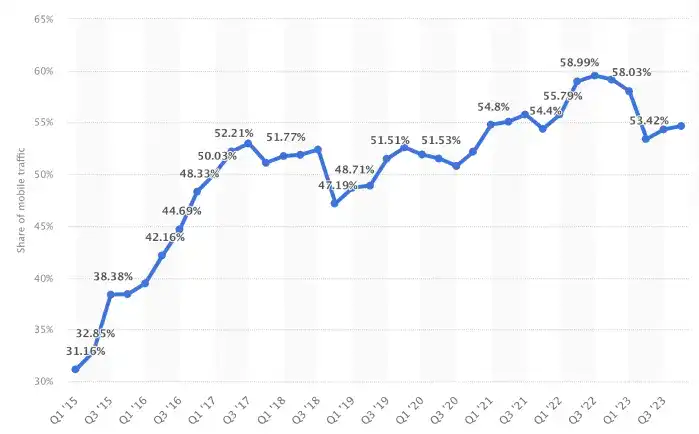TABLE OF CONTENTS
The Role of Responsive Website Design on SEO and Enhancing Google Credibility
In today’s fast-paced digital world, having a website that is both functional and visually appealing across various devices is no longer a luxury—it's a necessity.
Responsive Web Design (RWD) is the backbone of modern web development, ensuring that your site delivers a consistent experience whether viewed on a desktop, tablet, or smartphone.

Understanding Responsive Web Design
Responsive Web Design is a technique used in web development to make a website look good on all devices.
It automatically adjusts the layout, content, and images to fit the screen size and orientation of the device being used to view it. This adaptability improves the user experience, which is a key factor in the effectiveness of a site and its ability to retain visitors.
Interested in creating such adaptable websites? Check out our Web Design Course in HTML & CSS, tailored to equip you with the skills needed to build responsive and effective websites.
Why Responsive Design Is Essential
Enhanced User Experience
A responsive website provides a seamless experience across all devices.
Consider the frustration when you have to zoom in to read text or navigate through a site on your phone—it's cumbersome and discouraging. A responsive design eliminates these issues, resizing content and images appropriately to ensure the site is easy to use on any device. This fluidity leads to a higher level of user satisfaction and can significantly reduce bounce rates.
Imagine trying to book a flight on your smartphone on a site that isn't responsive. The text is tiny, you can't click the booking button without zooming in, and filling out the form is a nightmare.
Now, if the website were responsive, it would have adjusted to your screen size, made text legible, and simplified form filling—turning a frustrating experience into a smooth one. Learn to create user-friendly designs with our comprehensive HTML Web Design Course, and start improving the online experience for your users.
Increase in Mobile Usage
The growth of mobile internet usage is one of the most significant trends in the digital space. According to Statista, mobile devices, excluding tablets, generated about 58.03% of global website traffic in the first quarter of 2023.

This shift underscores the importance of having a website that performs well on smartphones and tablets, not just desktop computers.
How Responsive Design Affects SEO
Google has unequivocally stated that responsive design is its preferred method for mobile web design.
Here’s how responsive web design impacts SEO:
Mobile-First Indexing
As of September 2020, Google predominantly uses the mobile version of the content for indexing and ranking. This change is a response to the increase in mobile usage and signifies an essential shift in how Google views websites. Sites that are not mobile-friendly risk losing significant organic traffic, as they may not rank as well in search results.
Let’s take a blog for example that provides gardening tips and has a mobile-friendly design, ensuring that its rich content about organic gardening techniques is easily readable on mobile devices. This responsiveness makes it more likely to be indexed favorably by Google, leading to higher visibility and traffic.
Dive deeper into creating mobile-first websites with our HTML Web Design Course, where you'll learn the essentials of responsive design.
Page Load Speed
Page load speed is a ranking factor for Google.
Responsive sites tend to load faster on mobile devices because they use modern techniques like CSS3 and HTML5, which reduce the amount of data that travels over the network. Faster loading times lead to better user experiences and, consequently, higher search rankings.
Lower Bounce Rates
Responsive design can help lower bounce rates. Websites that are easy to navigate and read on any device are more likely to keep visitors engaged longer.When users stay on a site longer, it signals to Google that the website is providing valuable content, which can positively affect rankings.

A local restaurant’s website that adjusts smoothly to any device, providing easy access to menus, booking forms, and contact information without needing to pinch and zoom can significantly reduce bounce rates.
Visitors find what they need quickly and are more likely to make a reservation.
Google Credibility and Responsive Design
Credibility with Google isn't just about SEO; it's about trust. Google aims to provide users with the best possible search results, and that includes leading them to websites that offer a good user experience.
Responsive web design is seen as a best practice for creating trustworthy sites that provide a consistent and efficient user experience.
Better User Engagement
Websites that are responsive are more likely to engage users effectively.
For example, a user visiting a responsive site from a mobile device can navigate easily without the frustration of dealing with a non-mobile-friendly interface.
This ease of use encourages interaction with the content, such as registrations, sign-ups, and other engagement metrics that Google views favorably.
Enhanced Local SEO
For local businesses, mobile responsiveness is particularly crucial. A mobile-friendly website can attract local customers looking for quick answers while on the move.
For instance, if someone is searching for a nearby cafe, a responsive website with easy-to-access menus and a click-to-call phone number provides what they need quickly, likely converting them from a visitor to a customer.
Our Final Thoughts
Responsive Web Design is not just a technical requirement; it's a fundamental element that impacts user experience, SEO, and site credibility with Google.
By ensuring that your website is responsive, you not only cater to the growing number of mobile users but also boost your site's performance in search engine rankings. In a digital age where the competition is just a click away, making your website accessible and enjoyable to all users is essential.
Ready to build responsive websites that excel in user experience and SEO? Join our Web Design Course in HTML & CSS today for FREE at D-Libro and start crafting sites that stand out in the digital landscape.

